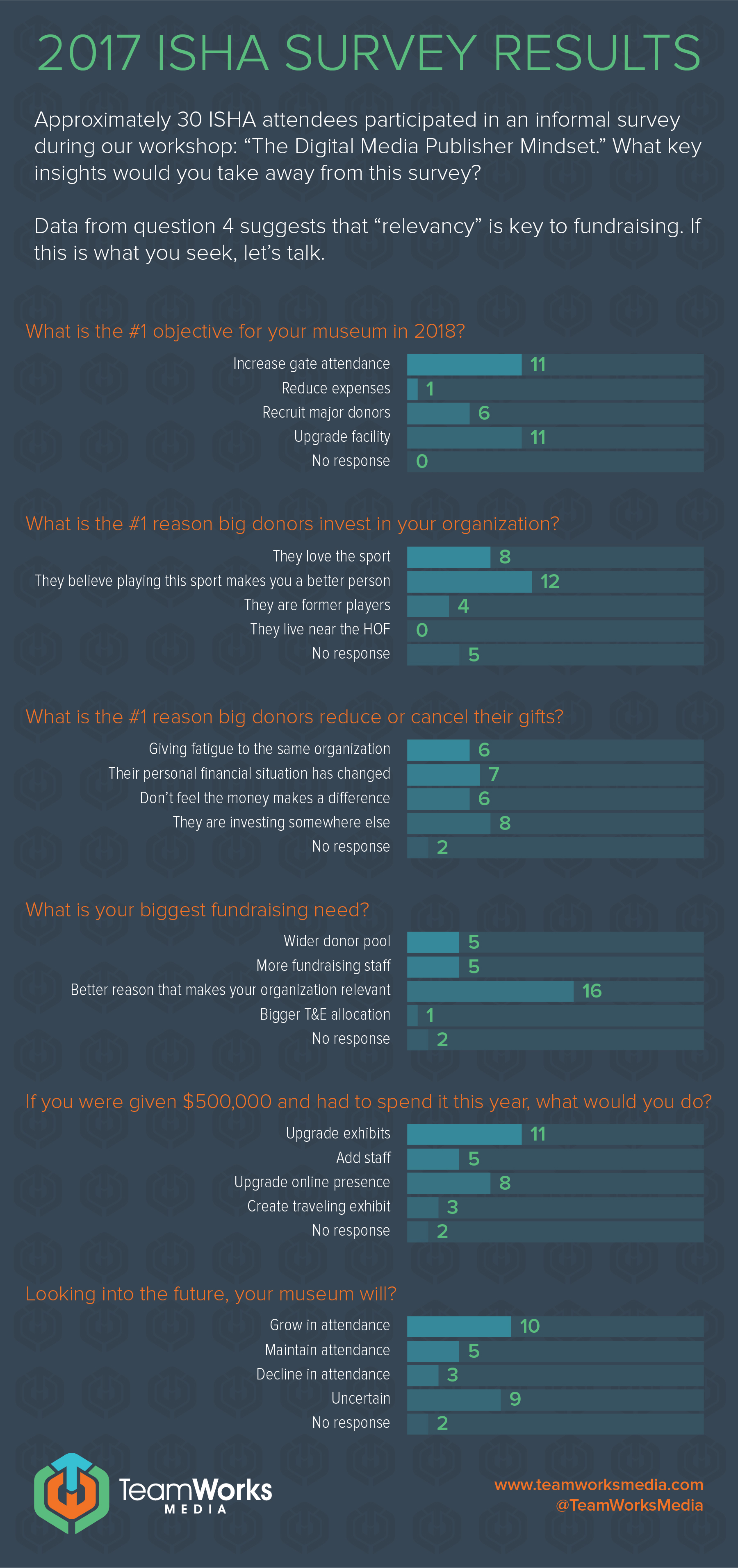Last week I attended the International Sports Heritage Association Conference in Knoxville, TN, better known as the annual conference for sports museums.
At the conference we took a survey of 75+ attendees about their biggest challenges and aspirations for the future.
I left the ISHA Conference with confirmation of three major issues facing sports museums today.
And all of it reminded me of a picture I have of my daughter Ellie.
SEVEN POINTS DOWN
Last year Ellie was a backup center on her high school varsity basketball team, the Glenbard West Hilltoppers. Her team was down seven with four minutes to go against a ranked opponent. Then Sam, our starting center, went on an offensive tear, ripping off 11 straight points to end the game and secure a four-point Hilltoppers victory.
 I love this picture of her and Sam after the game (Ellie has the ponytail and the black headband). So much of the emotion of those final minutes is reflected in this photo, from the foreground to the background.
I love this picture of her and Sam after the game (Ellie has the ponytail and the black headband). So much of the emotion of those final minutes is reflected in this photo, from the foreground to the background.
I sent this photo to her coach with a note that said:
“This is what basketball is all about. This why I played in high school and this is why I’m happy my daughter plays today. You win as a team, you lose as a team. The lessons and experiences learned on the court will apply to you for the rest of your life. Ellie is a better person because she plays. Basketball matters.”
WHAT WE’RE HEARING FROM MUSEUMS
Overall, ISHA attendees said the museum business is getting harder, especially for those that don’t have a geographic advantage. For example, the Green Bay Packers Hall of Fame is conveniently housed at legendary Lambeau Field. Most sports museums aren’t that lucky.
Here’s what sports museums at the conference identified as their major issues:
- Keeping their content relevant
- Getting people in the door
- Fundraising
One approach would be to develop tactic-specific solutions for each of the above problems. But these are all interconnected, so a better way to start is with a re-evaluation of why your original donors, sponsors, governing bodies, grant-givers, etc. want to support your mission. It’s about finding themes that are greater than statistics and trophies and celebrating those themes – whether in your physical space or in your digital communities. It’s a process that can open up new revenue sources while creating inspirational stories that fuel your mission.
THE QUESTIONS THAT DEFINE THE ISSUES

In the survey, two questions got the most attention:
- What is the biggest goal for your museum in 2018?
- What is the top reason donors support your organization?
Here’s what we heard from the 30 people who responded:
The top two goals for sports museums in 2018: add more technological innovation within the museum and increase gate attendance revenue.
These were the expected answers, but there is a fundamental conflict between these goals that took some time to unpack: There’s an assumption that increased gate revenue will follow the installation of new technology, but will that increased revenue outweigh the cost of the physical re-design, hardware, software, creation of new content and the installation of that technology?
Most people said no. Therein lies the problem. But a solution emerged in the answer to the second question.
The top two goals for sports museums in 2018: add more technology within the museum and increase gate attendance revenue.
WHAT’S YOUR STORY?
The top reason donors support your organization? A belief that participating in sports makes you a better person and donating to your museum helps bring that belief to life.
Most sports museums, and especially Halls of Fame, celebrate the accomplishments of the sport’s greatest athletes: Hank Aaron, Muhammad Ali, Michael Jordan, Jim Brown and Wayne Gretzky have all achieved success at the highest level. Their resumes are etched in stone in Halls of Fame around the country.
But is that what sports are all about? Is that what inspiration is all about?
If your biggest donors give passionately to your cause because they believe playing sports makes you a better person, then how, if at all, is your museum showcasing that idea in your museum? How is that message being represented online?
This is the gap and the opportunity.
To bridge the gap and meet that opportunity, we have to think back to that photo of Ellie’s basketball game. Or the photo of Scottie Pippen literally holding up Michael Jordan during “the flu game.” Or Gretzky’s famous quote about missing all the shots you don’t take.
You get the idea. But none of this starts with technology. It starts with a story.
THE FOUR-STEP PROCESS FOR SPORTS MUSEUMS TO FOLLOW
Technology isn’t inspirational, it’s simply a delivery mechanism for inspirational storytelling. If you want to drive revenue, it begins by re-engaging your donors, your governing bodies and your sponsors. That process begins by giving them what they want: a plan that showcases not just the greatest players and moments, but the values your sport imparts to players all around the world on a daily basis.
So how do you do this? We consider it a four-step process:
- Create a content strategy that frames themes and storylines that match the goals of your funders and your mission.
- Bring all the elements of your operations together under this strategy and framework – from marketing to programming to fundraising.
- Build a framework for how these stories will be told your space. (Remember, this shouldn’t require a complete rebuild of your facility.)
- Develop a digital platform that extends these stories and your mission to millions of fans worldwide instead of just the thousands who walk through your doors. (If millions seems far-fetched, read about what we’ve done with the Baseball Hall of Fame and La Vida Baseball.)
There’s more to say about all of the above and I’ll be exploring it more here in the weeks to come. But before we do, I’d love to hear what you think about this approach and how you’re tackling these problems in your own museum. And if you were at the International Sports Heritage Association convention, does this track with what you were hearing?
Get in touch with me here to let me know or subscribe to our newsletter below to get updates to this series.
